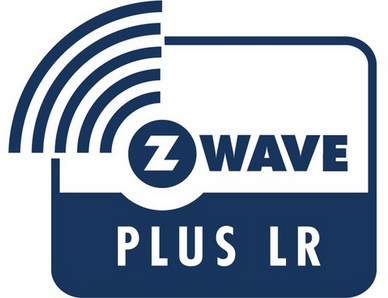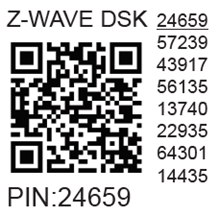Shelly Wave Dimmer EU LR
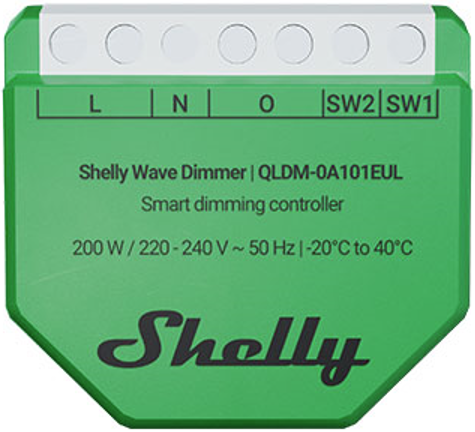
Device identification
Device: Shelly Wave Dimmer (EU)
EU Part number/Ordering Code: QLDM-0A101EUL
Z-Wave Product type ID: 0x0001
Z-Wave Product ID: 0x0083
Z-Wave Manufacturer: Shelly Europe
Z-Wave Manufacturer ID: 0x0460
This device supports both Z-Wave® (mesh) and Z-Wave® Long Range (star) network topologies. During the device inclusion process, you must select one type of network topology.
Bellow sections marked with * are valid only for Z-Wave® mesh network inclusion and are not applicable for Z-Wave® Long Range star network inclusion.
Terminology
Short description
The Device is a smart dimming controller which allows remote control of dimmable lights and dimming drivers through a mobile phone, tablet, PC, or home automation system. The Device can be used as trailing edge dimmer switch, with or without neutral wire.
Use cases
Basic functions
SmartStart
Assocciations
Working as Z-Wave repeater
Input modes
Output types
Minimum Brightness on Toggle On
Min/max brightness definition
Button fade rate definition
Single button dimming control
Dual button dimming control
Transition Duration
Calibration
Measuring Voltage (V), Power consumption (W), Energy consumption (kWh), Current (A) of all connected loads.
OTA - Over-The-Air firmware update
No need for neutral: The Device can be used without neutral wire
Bypass: Bypass is required when the device is used without neutral and the load is under 5 W. Bypass could help when there is light coming from the lamp even when it is turned off.
Groups of lights: Groups of lights can be used, but they should have the same consumption (should have the same model and producer)
Operational Instructions:
Main applications
Residential
MDU (Multi Dwelling Units - apartments, condominiums, hotels, etc.)
Light commercial (small office buildings, small retail/restaurant/gas station, etc.)
Government/municipal
University college
Integrations
Shelly Wave devices are developed on the world's leading technology for smart homes – Z-Wave.
This means Shelly Wave works with all certified gateways supporting Z-Wave communication protocol.
To make sure the functions of Shelly Wave products are supported on your gateway, we are regularly executing compatibility tests of our devices with different Z-Wave gateways.
Simplified internal schematics

Device electrical interfaces
Inputs
2 switch/push-button inputs on screw terminal
3 power supply inputs on screw terminals: N, 2 L
Outputs
2 outputs
Connectivity
Unsecure, S0 Security, S2 Unauthenticated Security, S2 Authenticated Security
Safety features
Overheat Protection
Overcurrent Protection
Overvoltage Protection
Supported load types
Dimmable LED lamps: up to 150W
Incandescent bulbs: up to 200W
Halogen lamps: up to 200W
Iron-core transformer with low-voltage incandescent lamps: up to 200VA
Dimmable electronic transformers: 200W
User interface
S button and operating modes
Settings mode:
Is required to start the desired procedure, for example: adding (inclusion (*not available for Long Range devices)), removing (exclusion), factory reset, etc. It has a limited operating time. After completing the procedure in Setting mode, the Device automatically switches to Normal mode.
Entering Setting mode:
Press and hold the S button on the Device until the LED turns solid blue.
An additional quick press on the S button changes the menu in an infinite loop.
The Menu LED status has a timeout of 10s before entering again into Normal mode.
S button’s functions
Manually adding the Device to a Z-Wave network (*not available for Long Range inclusion)
Manually removing the Device from a Z-Wave network
Factory Reset the Device
Calibration
LED Signalisation
LED blinking modes
Technical Specifications
Power supply | 220-240 V ̴ 50 Hz | |
Power consumption | < 0.3 W | |
Neutral not needed | Yes | |
Min. load without neutral and without a Bypass | 5W (depends on LED type, in case of flickering use bypass) | |
External protection | 10 A, tripping characteristic B or C, | |
Dimming type | Trailing edge | |
Power measurement [W] | Yes | |
Max. output power | 200 W | |
Internal-temperature sensor | Yes | |
Overheating protection | Yes | |
Overcurrent protection | Yes | |
Overvoltage protection | Yes | |
Long range network | Distance (depends on local condition) | Up to 80 m indoors (262 ft.) or up to 1000 m outdoors (3281 ft.) |
Z-Wave® repeater | No | |
Z-Wave® frequency bands | 864 MHz | |
Mesh network | Distance (depends on local condition) | Up to 40 m indoors (131 ft.) |
Z-Wave® repeater | Yes | |
Z-Wave® frequency bands | 868.4 MHz | |
Maximum radio frequency power transmitted in frequency band(s) | < 25 mW | |
CPU | Z-Wave® S800 | |
Size (H x W x D) | 37x42x16 ±0.5 mm / 1.46x1.65x0.63 ±0.02 in | |
Weight | 25 g / 0.88 oz. | |
Mounting | In-wall box | |
Screw terminals max. torque | 0.4 Nm / 3.5 lbin | |
Conductor cross section | 0.2 to 2.5 mm² / 24 to 14 AWG (solid, stranded, and bootlace ferrules) | |
Conductor stripped length | 6 to 7 mm / 0.24 to 0.28 in | |
Shell material | Plastic | |
Color | Lime | |
Ambient temperature | -20°C to 40°C / -5°F to 105°F | |
Humidity | 30% to 70% RH | |
Max. altitude | 2000 m / 6562 ft | |
Basic wiring diagram
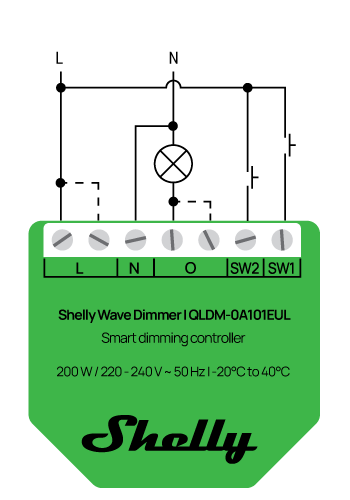
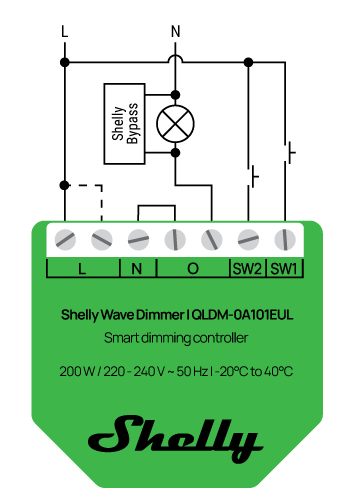
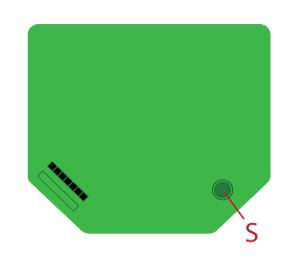
Legend
Device terminals:
N: Neutral terminal
L: 2x Live terminal (220-240 V AC)
SW1: Switch/push-button input terminal
SW2: Switch/push-button input terminal
O: 2x Load circuit output terminals
Wires:N: Neutral wire
L: Live wire (220-240 V AC)
Button:S: S button
With Neutral (Fig.1)
Connect the Live wire to the Device L terminal, and the Neutral wire to the N terminal.
Connect the load to the O terminal of the Device and the Neutral wire.
If you want to control the dimming with two buttons, connect buttons to the SW1 and SW2 terminals.
Without Neutral, with Bypass (Fig.2)
Connect the Live wire to the Device L terminal.
Connect the load to the O terminal of the Device and the Neutral wire.
Connect a wire to the other O terminal and the N terminal as shown in the wiring diagram. Connect the Shelly Bypass in parallel to the load.
If you want to control the dimming with two buttons, connect buttons to the SW1 and SW2 terminals.
About Z-Wave®
Adding and removing the Device to a Z-Wave® network
Security and Device Specific Key (DSK)
Setting Parameters
Command Classes
Notifications Command Class
Associations
Disclaimers and Warnings
READ BEFORE USE
This document contains important technical and safety information about the Device, its safe use and installation.
Z-Wave® Important disclaimer
Z-wave® wireless communication may not always be 100% reliable. This Device should not be used in situations in which life and/or valuables are solely dependent on its functioning. If the Device is not recognized by your gateway or appears incorrectly, you may need to change the Device type manually and ensure that your gateway supports Z-wave Plus® multi-channel devices and Z-wave® Long Range capability in case of Long Range devices.
Compatibility
Wave Dimmer | functions - reports | ||||||||
Gateway | Dimming | SW Dimming | D Control 1 | D Control 2 | D Binary 1 | D Binary 2 | W | kWh | Notes |
Home Assistant |
|
|
|
|
|
| ❌ | ❌ | *1 |
Fibaro - HC 3 / Wave engine 3 |
|
|
|
|
|
| ❌ | ❌ | *1 |
Homey | TBD | TBD | TBD | TBD | TBD | TBD | TBD | TBD | *H |
Homee Gen 7 |
|
|
|
|
|
| ❌ | ❌ | |
Homee Gen 5 |
|
| ❌ | ❌ |
| ❌ |
|
| *2, *3 |
Smart Things |
|
| ❌ | ❌ | ❌ | ❌ |
|
| *2, *3, *4 |
Vera Ezlo | TBD | TBD | TBD | TBD | TBD | TBD | TBD | TBD | |
Cozify | TBD | TBD | TBD | TBD | TBD | TBD | TBD | TBD | |
Notes | *H Troubles with reports can be solved with this solution. | ||||||||
Function | Meaning / tested |
|---|---|
On/Off | if device respond to the app UI On/Off command |
SW On/Off | if device reports On/Off changes by SW input |
Dimming | if device respond to app UI dimming command |
SW Dimming | if device report dimming state change by SW input |
Watts | if Watts are reported (unsolicited) |
kWh | if kWh are reported (unsolicited) |
Up/Down | if device respond to the app UI Up/Down command |
SW Up/Down | if device reports Up/Down changes by SW input |
Slats | if the slats respond to the app UI command |
SW Slats | if the slats report the changes done by SW |
D control | detached mode if device reports scene commands single press, double press,… |
D Binary | detached mode if the device reports binary On/Off by SW input |
Sensor # | Is the sensor report visualized in the gateway, type of sensor in the notes. |
Legend | ||||
Symbol | State | |||
| Working / Possible | |||
❌ | Not Working / Not Possible | |||
P | Partially | |||
N/T | Not Tested | |||
TBD | To be done | |||
Compliance
Shelly Wave Dimmer multilingual EU declaration of conformity 2025-07-30.pdf
Shelly Wave Dimmer LR UK PSTI ACT Statement of compliance.pdf
Declaration of Conformity
Hereby, Shelly Europe Ltd. declares that the radio equipment type Shelly Wave Dimmer is in compliance with Directive 2014/53/ EU, 2014/35/EU, 2014/30/EU, 2011/65/EU. The full text of the EU declaration of conformity is available at the following internet address: https://shelly.link/WaveDimmer_LR-DoC
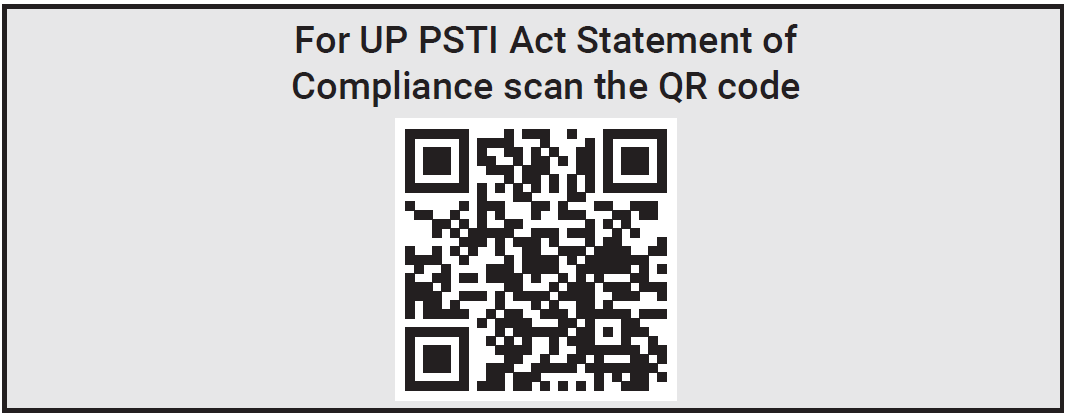
.png?inst-v=03c1c465-2fb8-44b5-b6aa-9a6d4f716ab1)
Disposal & Recycling
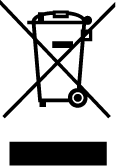
Do not dispose of the product in household waste. Recycle the product to prevent environmental and health damage and to promote resource conservation. Dispose of the product at an appropriate waste collection point at your own responsibility.
Resellers, from which the Device was purchased are required to accept Waste Electrical and Electronic Equipment (WEEE) free of charge for proper disposal.
Some electronic products may store personal data. The user is responsible for deleting this data before disposing of the Device. For deletion reset the Device to its factory settings.
Printed User Guide
Shelly_Wave_Dimmer_EU_LR_8lang_V1_A_B2513-print.pdf
Shelly_Wave_Dimmer_EU_LR_16-lang-eview.pdf
WEB pages
Troubleshooting
Gateway guides
You may find useful guides on gateways in the Z-Wave Z-Wave Gateways
Firmware
Latest firmware updates:
Stay Updated with the Firmware Releases for Shelly Wave Devices
all firmware updates:
GitHub - Shelly Wave FW OTA files
Integration
All shelly devices:
Discover Compatible Gateways for our Devices
Webpages
Product page
Manufacturer
Shelly Europe Ltd.
Address: Shelly Europe ltd, 51 Cherni Vrah Blvd., building 3, floor 2 and 3, Lozenetz Region, Sofia 1407, Republic of Bulgaria
Tel.: +359 2 988 7435
E-mail: zwave-shelly@shelly.cloud
Support: https://support.shelly.cloud/
Changes in the contact data are published by the Manufacturer at the official website: https://www.shelly.com
Legal Notice
This User Guide is subject to change and improvement without notice. Shelly Wave reserves all rights to revise and update all documentation without any obligation to notify any individual or entity.















